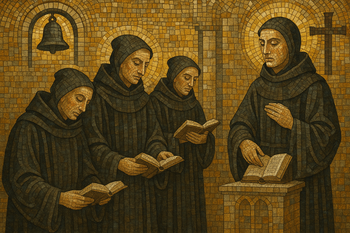Receive God's Love, Proclaim the Greatness of the Lord, Serve Joyfully & Make Missionary Disciples of Jesus Christ
-

The Divine Office and its prayers have roots in Jewish tradition when sacrifices and prayers would be offered during the morning and evening. Additionally there is a mention of seven times of daily prayer in Psalm 119. Early Christian adaptations of these prayers developed differently in various regions and religious communities. Typically, there would be morning and evening prayers as well as shorter prayers at the 3, 6, & 9th hours of the day. With the formalization of Benedictine order there developed a standard for praying the hours which many religious communities would adapt themselves.
vigil / matins (nighttime) ~2am-dawn
lauds (dawn), ~5am
prime (sunrise), ~6am
terce (mid-morning), ~9am
sext (midday), ~Noon
none (mid-afternoon,) ~3pm
vespers (sunset), ~6pm
compline (retiring) ~7pm
*times would vary seasonally and depending on the time of sunrise and sunset
The construction of these different liturgies could be quite complex being a mixture of common prayers, hymns, various psalms, scripture readings, plus lessons from and stories of saints lives. Keeping all of the materials at hand could be quite cumbersome with various liturgical books to use (psalter, lectionary, etc…). Out of necessity a new book would be developed a Breviary which would combine all of these elements together in one source. The Franciscans helped popularize and spread the breviary across Europe.
It is not uncommon for church bells to be used as a call to prayer for the various liturgical hours (not dissimilar from the Islamic call to prayer). With the Council of Trent in the 1500’s a more universal Roman Catholic breviary began to form and persists to this day. Vatican II revisions sought to make the use of the Divine Office/Liturgy of the Hours more accessible to the laity for daily use. Adjustments include renaming the hours and categorizing them as major hours (Office of Readings, Morning Prayer, and Evening Prayer) and minor hours (Midmorning, Midday, Midafternoon, and Night Prayer), If you compare the lists you may notice that a corollary for prime(sunrise) does not exist. It was determined because of the similarities between lauds and prime and their proximity of time that prime would be suppressed.
Future articles will delve into the unique aspects and general construction of the liturgies in hopes that you may find that would be beneficial to your prayer life.
++RINCÓN DE LITURGIA
El Oficio Divino + Desarrollo Histórico
El Oficio Divino y sus oraciones tienen sus raíces en la tradición judía, donde se ofrecían sacrificios y oraciones por la mañana y por la tarde. Además, el Salmo 119 menciona siete momentos de oración diaria. Las adaptaciones cristianas primitivas de estas oraciones se desarrollaron de forma diferente en las distintas regiones y comunidades religiosas. Normalmente, se incluían oraciones matutinas y vespertinas, así como oraciones más breves a las 3, 6 y 9 horas del día. Con la formalización de la orden benedictina, se desarrolló un estándar para el rezo de las horas, que muchas comunidades religiosas adaptaron.
vigilia / maitines (nocturno) ~ 2 am-amanecer
laudes (amanecer), ~5am
Amanecer, ~6 am
terce (media mañana), ~9 am
sexta (mediodía), ~mediodía
ninguna (media tarde), ~3pm
vísperas (atardecer), ~6pm
Completas (retirada) ~7pm
*Los horarios varían según la temporada y dependiendo de la hora del amanecer y del atardecer.
La elaboración de estas diferentes liturgias podía ser bastante compleja, ya que combinaban oraciones comunes, himnos, salmos, lecturas de las Sagradas Escrituras, además de lecciones e historias de la vida de los santos. Mantener todos los materiales a mano podía resultar bastante engorroso, dado que se utilizaban diversos libros litúrgicos (salterio, leccionario, etc.). Por necesidad, se desarrolló un nuevo libro, el Breviario, que combinara todos estos elementos en una sola fuente. Los franciscanos contribuyeron a popularizar y difundir el breviario por toda Europa.
No es raro que las campanas de la iglesia se utilicen como un llamado a la oración para las diversas horas litúrgicas (similar al llamado islámico a la oración). Con el Concilio de Trento en el siglo XVI, comenzó a formarse un breviario católico romano más universal que persiste hasta nuestros días. Las revisiones del Vaticano II buscaron hacer que el uso del Oficio Divino/Liturgia de las Horas fuera más accesible para los laicos para su uso diario. Los ajustes incluyen renombrar las horas y categorizarlas como horas mayores (Oficio de Lecturas, Oración de la Mañana y Oración de las Vísperas) y horas menores (Media mañana, Mediodía, Media tarde y Oración de la Noche). Si compara las listas, puede notar que no existe un corolario para prima (amanecer). Se determinó que, debido a las similitudes entre laudes y prima y su proximidad temporal, se suprimiría la prima.
Los artículos futuros profundizarán en los aspectos únicos y la construcción general de las liturgias con la esperanza de que puedan resultar beneficiosos para su vida de oración.